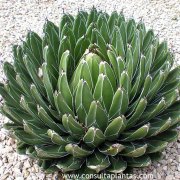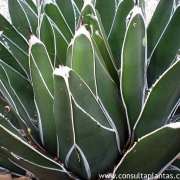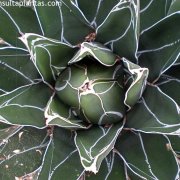Care of the succulent plant Agave victoriae-reginae or Queen Victoria agave |
|
The Agave genus, a subfamily of the Agavoideae, comprises some 300 species of succulent plants native to Mexico, Central America and the Southwest of the USA. Some species are: Agave victoria-reginae, Agave vivipiara, Agave palmeri, Agave striata, Agave stricta, Agave sisalana, Agave shawii, Agave potatorum, Agave parryi, Agave parrasana, Agave macroacantha, Agave filifera, Agave bracteosa, Agave attenuata, Agave americana, Agave guadalajarana, Agave impressa, Agave ferdinandi-regis, Agave univittata, Agave lechuguilla, Agave angustifolia, Agave vilmoriniana, Agave datylio, Agave deserti, Agave chiapensis. Common names: Queen Victoria agave, Royal agave. This species is native to Mexico. They are small succulent plants (less than 50 cm/1.64 feet in diameter) and slow growing, very suitable for growing in pots. They form a very elegant rosette with dark green leaves with white striations. They die after flowering. Agave victoria-reginae needs a very sunny exposure. They support frost if the substrate is dry. The soil should be a mixture of leaf mulch and coarse sand with 1/4 of the garden substrate. Queen Victoria agave needs weekly watering in summer and almost zero in winter, as it remains at rest. Agave victoriae-reginae is not usually attacked by pests and diseases typical of gardens. Royal agave can be propagated from seeds that we will collect from the plant itself after flowering or by propagule (Structure that serves for the vegetative reproduction of an organism). |
Images of the succulent plant Agave victoriae-reginae or Queen Victoria agave |
Find plants
Agave victoriae-reginae or Queen Victoria agave | Care and Growing
© 2025 FavThemes


